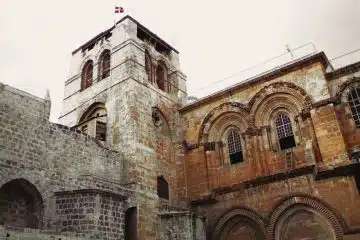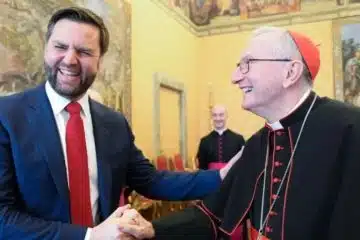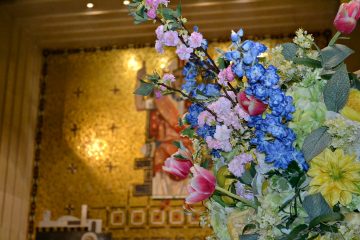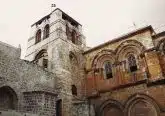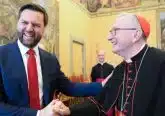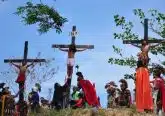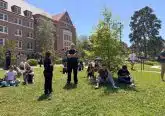Bishop’s memories of World War II Army service in Italy still vivid

IMAGE: CNS photo/Archdiocese of Philadelphia
By Lou Baldwin
PHILADELPHIA (CNS) — It is no accident that each year many films shown on television between Memorial Day and the June 6 anniversary of D-Day center on World War II.
After all, with more than 16 million men and women under arms, it was easily the largest and deadliest war ever fought by the United States.
Only a tiny percentage of them are still alive, and one of them is a Catholic bishop — retired Philadelphia Auxiliary Bishop Louis A. DeSimone, 95.
Back in 1944, he was Sgt. Louis DeSimone, a 22-year-old translator of Italian attached to the headquarters of the U.S. Fifth Army. Joining it in Casablanca, Morocco, during the African campaign and continuing through Sicily, up the Italian boot to Montecassino and after that to the deadly Anzio beach landing, he arrived in Rome a few days after the bloodless liberation of the Italian capital.
He could not know it immediately, but this last event would affect his entire life.
Bishop DeSimone minimizes his wartime exploits by explaining he was not a frontline infantryman, he was part of the support staff. But the young sergeant was definitely in harm’s way, just a step or two behind the action. He saw things he would rather forget.
A Pennsylvania native born in Bridgeport in 1922, Bishop DeSimone is the eldest and last surviving of three brothers. The thought of priesthood was on his mind, but he wasn’t quite sure about it at the time.
While he was at then-Villanova College, America entered World War II. A military recruiter came to the campus telling students they could enlist to serve in the branch of their choice but stay in school until they were needed.
“I chose the Army because my father (Anthony DeSimone) was an American soldier in France during World War I,” Bishop DeSimone said. “I wasn’t sorry to go in, I wanted to serve my country.”
He was just one semester shy of graduation when the recruiters came back and told him it was time. The reason became clear later. There was a need for young men who could speak Italian fluently because the invasion of Italy was on the drawing board.
After his stateside training — the only time he actually fired a gun — he was shipped off to Casablanca and assigned to Fifth Army headquarters there as a translator. He worked mostly under the chief chaplain, Father John Ryan, who was a major.
Sgt. DeSimone’s task would be smoothing communications with the local population and sometimes finding a priest who could celebrate Mass for the troops or refugees. He also sometimes worked as an interpreter for other officers, including Gens. Mark Clark and Alfred Gruenther.
After leaving Casablanca in summer 1943, his first stop across the Mediterranean was Sicily, then up through southern Italy with hard fighting all the way.
As the Fifth Army worked its way north, Bishop DeSimone especially remembers the swarm of planes thick as locusts on their way to bomb Montecassino. By this time, the Mussolini government had fallen and most of Italy was occupied by German army units, including those firmly entrenched around the historic abbey.
Italian officers who had come over to the Allies, Bishop DeSimone recalled, advised against the bombing because the occupying Germans were in caverns under the abbey unreachable by the bombs. But it was bombed anyway.
By the time Sgt. DeSimone arrived at the scene, the fighting had moved on, but the abbey was just rubble.
“It was mostly people from the town who came up to the abbey for protection that died,” Bishop DeSimone said in an interview with CatholicPhilly.com, the news website of the Archdiocese of Philadelphia.
He also recalled the deadly battle for Anzio not far from Rome, which began Jan. 22, 1944, where the Allied forces made a surprise beachhead landing. While successful in the end, more American soldiers died in a single day in that battle than any other of the war.
Through it all, “You could not miss the horror, not only the military deaths but the starving people. It was an unbelievable experience,” said Bishop DeSimone.
He went ashore after the heavy fighting, disembarking from a tank landing ship, known as an LST. It was a flat-bottomed landing craft in use at that time.
While in the area, he happened upon a local cemetery. Trucks were pulling up and literally dumping the bodies or body parts on the ground, where burial crews wearing masks were sorting them out by nationality for interment.
After an Allied breakthrough near Rome, the German high command decided not to defend the city and retreated, leaving it almost intact. A Fifth Army contingent entered it June 5, 1944, and Bishop DeSimone said that when he arrived two or three days later, the crowds were still cheering and blowing kisses to the American soldiers.
One of his first tasks was to accompany Father Ryan, the chaplain, to Vatican City, a neutral party during the war. Its great plaza was blocked off by a high wooden wall. They met with Vatican City’s president, Cardinal Nicola Canali, and arranged for a victory Mass to be celebrated at Santa Maria Della Angeli, a huge church.
“We had 10,000 troops there, Gen. Clark and Gen. Guenther also attended,” Bishop DeSimone recalled.
Pope Pius XII had several audiences for the troops. One particularly stands out in Bishop DeSimone’s mind because he was given a front seat as an Italian speaker. The pope actually spoke very good English.
Pope Pius went down the line giving individual soldiers a warm greeting and asking them what they did in civilian life.
“When he came to me and grabbed my hand, I told him I was thinking of becoming a priest,” Bishop DeSimone recalled. Pope Pius replied, “I’ll pray for you.” Right then Sgt. DeSimone decided yes, he would be a priest.
“I used that in my letter of application to St. Charles Seminary,” he said. “I think that’s what got me in.” He also received a recommendation for the seminary from Msgr. (later Cardinal) Francis Brennan, whom he met in Rome. The Philadelphia priest and Vatican official opted to remain in Vatican City during the war.
After he returned home, Sgt. DeSimone applied and was accepted. Meanwhile, his brother Russ entered the Augustinians and a bit later his brother Sal entered the seminary for the Diocese of Camden, New Jersey.
Louis A. DeSimone was ordained to the priesthood by Archbishop John F. O’Hara May 10, 1952. He was named an auxiliary for Philadelphia in 1981, finally retiring in 1995.
Of the many wonderful events in his life, and of all the distinguished people he encountered, it is that brief conversation with Pope Pius XII, after which he said yes to the Lord, that is the most unforgettable.
He well knows that just because he carried a carbine and didn’t fire a machine gun, he very easily could have been killed at almost any time on that long journey through Sicily and Italy to Rome. He wasn’t, and he thanks God for this and for every blessing that followed.
– – –
Baldwin writes for CatholicPhilly.com, the news website of the Archdiocese of Philadelphia.
– – –
Copyright © 2017 Catholic News Service/U.S. Conference of Catholic Bishops. www.catholicnews.com. All rights reserved. Republishing or redistributing of CNS content, including by framing or similar means without prior permission, is prohibited. You may link to stories on our public site. This copy is for your personal, non-commercial use only. To request permission for republishing or redistributing of CNS content, please contact permissions at [email protected].



